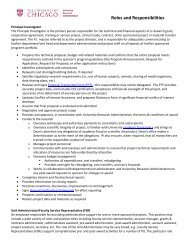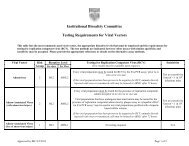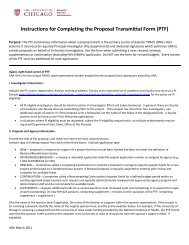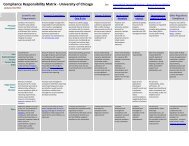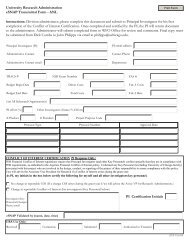Biosafety Considerations for Research with Lentiviral Vectors
Biosafety Considerations for Research with Lentiviral Vectors
Biosafety Considerations for Research with Lentiviral Vectors
Create successful ePaper yourself
Turn your PDF publications into a flip-book with our unique Google optimized e-Paper software.
Sections from the NIH GuidelinesGeneral <strong>Considerations</strong>Section II-A. Risk AssessmentAPPENDIXSection II-A-3. Comprehensive Risk Assessment. BL2 containment is recommended<strong>for</strong> activities involving all blood-contaminated clinical specimens, body fluids, and tissuesfrom all humans, or from HIV – or HBV-infected or inoculated laboratory animals.Activities such as the production of research-laboratory scale quantities of HIV or otherbloodborne pathogens, manipulating concentrated virus preparations, or conductingprocedures that may produce droplets or aerosols, are per<strong>for</strong>med in a BL2 facility usingthe additional practices and containment equipment recommended <strong>for</strong> BL3. Activitiesinvolving industrial scale volumes or preparations of concentrated HIV are conducted ina BL3 facility, or BL3 Large Scale if appropriate, using BL3 practices and containmentequipment.AppendixSection III-D. Experiments That Require Institutional <strong>Biosafety</strong> CommitteeApproval Be<strong>for</strong>e InitiationSection III-D-3. Experiments Involving the Use of Infectious DNA or RNA Virusesor Defective DNA or RNA Viruses in the Presence of Helper Virus in Tissue CultureSystems. Recombinant DNA or RNA molecules derived therefrom, which contain lessthan two-thirds of the genome of any eukaryotic virus (all viruses from a single Family(see Section V-J, Footnotes and References of Sections I-IV) being considered identical(see Section V-K, Footnotes and References of Sections I-IV), are considered defectiveand may be used in the absence of helper under the conditions specified in Section III-E-1, Experiments Involving the Formation of Recombinant DNA Molecules Containing NoMore than Two-Thirds of the Genome of any Eukaryotic Virus.Section III-E. Experiments That Require Institutional <strong>Biosafety</strong> Committee NoticeSimultaneous <strong>with</strong> InitiationSection III-E-1. Experiments Involving the Formation of Recombinant DNAMolecules Containing No More than Two-Thirds of the Genome of any EukaryoticVirus. Recombinant DNA molecules containing no more than two-thirds of the genomeof any eukaryotic virus (all viruses from a single Family being considered identical [seeSection V-J, Footnotes and References of Sections I-IV]) may be propagated andmaintained in cells in tissue culture using BL1 containment. For such experiments, itmust be demonstrated that the cells lack helper virus <strong>for</strong> the specific Families ofdefective viruses being used. If helper virus is present, procedures specified underSection III-D-3, Experiments Involving the Use of Infectious Animal or Plant DNA or RNAViruses or Defective Animal or Plant DNA or RNA Viruses in the Presence of HelperVirus in Tissue Culture Systems, should be used. The DNA may contain fragments ofthe genome of viruses from more than one Family but each fragment shall be less thantwo-thirds of a genome.



